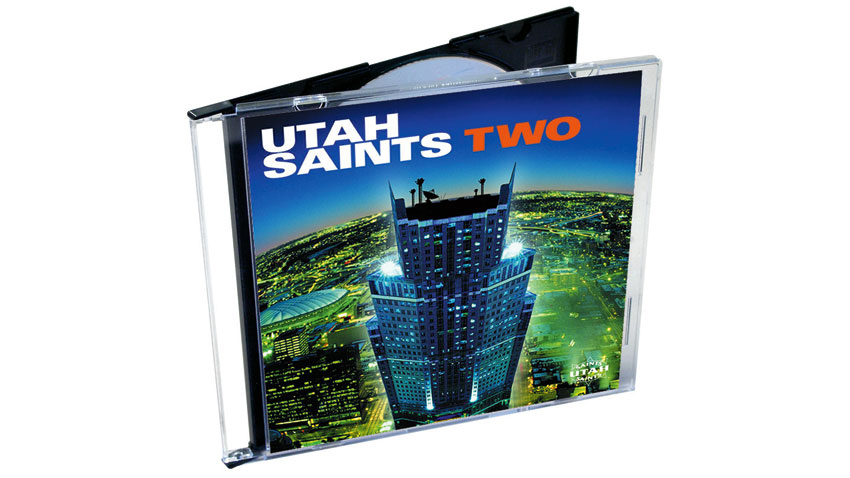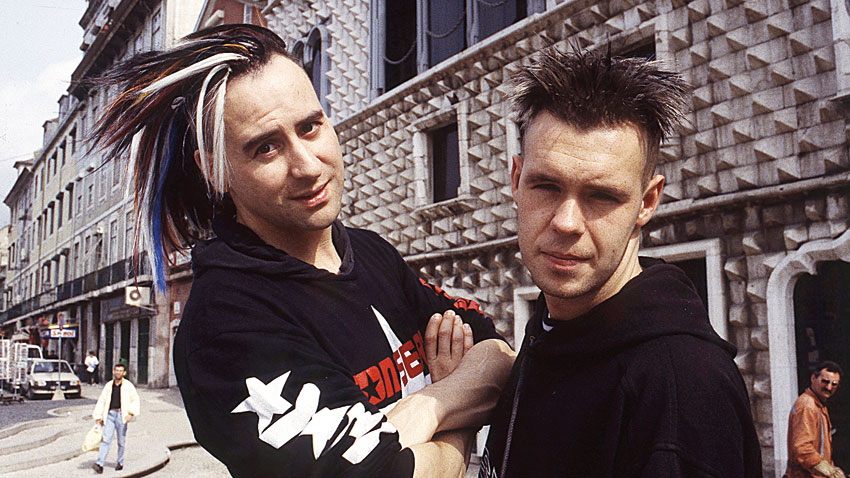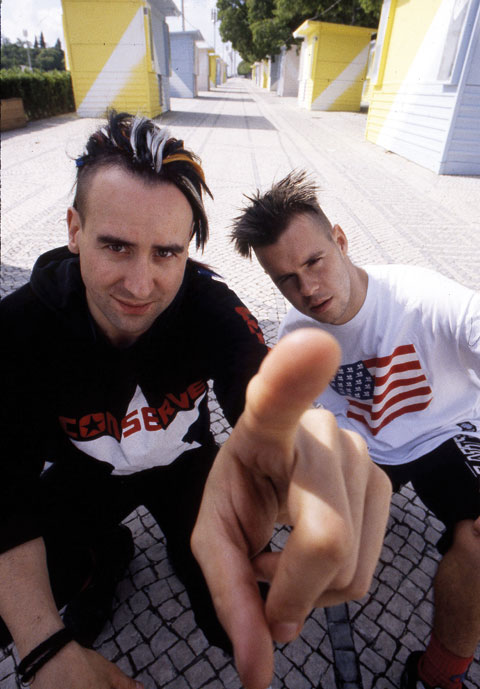Classic Album: Utah Saints on Two
Jez Willis and Tim Garbutt take a look back over their sample-packed second album

You’re only as good as your last album, and the Utah Saints’ debut set the bar pretty high. Three top ten hits, success in America, and a six-album deal with London Records. How do you follow that? For Tim Garbutt and Jez Willis, the obvious choice was to hand in an album of anti-hits and ultra-fast techno bangers so radio-unfriendly that they were promptly dropped from a label expecting more pop hooks and effortlessly marketable stadium dance beats.
“Everyone at the label was excited about the album they thought we would be working on,” says Jez. “It was all big studio time, and they had imagined that it was going to be full of hits. But, instead, we had a track that sampled Nick Cave saying the line ‘Hands up! Who wants to die?’, over a gabba beat! The label were absolutely terrified of the direction we were going, so we were quietly let go.”
Adrift and alone, the duo scrapped that and returned to where they belonged - a tiny studio, surrounded by gear. Locked off from a label at a loss as to what to do with such challenging electronic music. “We binned off that project,” says Tim. “We just had to psychologically draw a line under it.”
Liberated, an unhurried process of songwriting unfolded and an Indie record label, sensitive to their needs, offered to put it out. Pressure off, they laboured over the tracks, and as the arrangements took shape, a raft of star collaborators climbed aboard. Rap firebrand Chuck D joins soul legend Edwin Starr in the album credits, while everyone from Chrissie Hynde to Iggy Pop popped up into the sampler.
The most ‘self-sabotaging-but-love-em-for-it’ addition has to go to their use of REM frontman, Michael Stipe, who holds the album together via a curious series of spoken word interludes. “Yeah, he was actually up for doing a proper song,” chuckles Jez. “But instead we just recorded some conversations down the phone, which we then soundtracked.
“If we were on a different label they’d just see dollar signs! But we’ve never been brilliant business people.” [Laughs].
Well, it’s not all about the business, is it? Here, Tim and Jez talk us through their star-studded long-player.
Want all the hottest music and gear news, reviews, deals, features and more, direct to your inbox? Sign up here.

Sun
Tim: “This has Michael Stipe from REM on it. It was a conversation we had with him down the phone and we wrote music to go underneath. He got onboard because he said our debut was his favourite ever dance album.”
Jez: “Him and Courtney Love used to dance around to it, apparently!”
Tim: “We thought it would be cool to do a track with him, but really wanted to do something different. He wasn’t gonna sing, just talk, and we’d make it into interludes on the album between tracks, this being the first.”
Power To The Beats
Jez: “Remember Napster? There was a big debate in the US Senate with two sides talking about it. You had Lars Ulrich from Metallica saying it was bad, and Chuck D from Public Enemy saying it was good.
“We thought that putting both these people on one track would be a great statement, so we sampled Enter Sandman and had Chuck rap over it. Nobody apart from Tim and me got it [laughs]. We didn’t expect Metallica to clear the sample. It’s the only time they’ve ever done that, and they were amazingly nice about it.”
Love Song
Tim: “This samples Average White Band [Pick Up The Pieces]. We both just really liked that guitar sound on that record. We just looped it up in the Akai and it just had an awesome stereo sound. You could just ping it left and right.
“It was inspired by Dark & Long by Underworld. Not that this sounds like that, really, but we loved that vibe and the way it could just stay on a groove the whole way.”
Jez: “I sing on this. Neither of us are particularly keen on doing vocals, but on some tracks I had to do them as we couldn’t find a sample to fit. We heavily vocodered it, though.”
Lost Vagueness
Jez: “This samples The Pretenders’ I Go To Sleep. Electronic music-wise, it’s probably one of the tracks we are most proud of. Though it’s not an obvious house banger, it just had a lot in it. It all just kinda worked.
“Out of all the tracks we’ve ever put out, this is the one that seems to have resonated the most. We still get people saying how much it meant to them at different parts of their lives.”
Tim: “We had lots of big remixes done. The trance remix by Oliver Lieb is always in Tiësto’s all time top tens.”
Punk Club
Jez: “Michael Stipe, again. He started naming so many places in a conversation, then said the words ‘punk club’, which we really liked. So we cut it all up to make him take you on a little trip around America, ending up in a punk club. Then we added a little groove to what he was saying.
“These tracks were the last things we did for the album. It was also a little homage to It’s Grim Up North by KLF. It was sort of like a lighter version of that.”
Michael Stipe, again. He started naming so many places in a conversation, then said the words ‘punk club’, which we really liked. So we cut it all up to make him take you on a little trip around America, ending up in a punk club.
Funky Music
Tim: “Edwin Starr is on this track, and Paul Epworth engineered it at Strongroom Studios.”
Jez: “Paul would go on to work with Adele. It was great to have him and Edwin in the same room. Edwin was a complete soul legend.”
Tim: “We did TFI Friday with him. Remember that, with Chris Evans? It was meant to be a tightly-scripted performance, but he had too much funk and basically freestyled it. He was just a showman.”
Jez: “I don’t know if funk purists embraced our version of this song. But it got playlisted on Radio 1, and exposed a lot of new people to Edwin’s music.”
Massive
Jez: “We really wanted to sample some Tuvan throat singers. Tuva is a little country near Mongolia. It’s one of the earliest forms of singing.
“We nearly didn’t use it cos Massive Attack used a similar sample a few years earlier, but it was such a powerful, interesting voice that we wanted to do something around that.
“We gave it a nice, cinematic vibe. I played it to my son recently and it gets to that sample and he said, ‘That sounds really weird’. Yeah, it does. Maybe we shouldn’t have done it [laughs].”

Rhinoceros
Jez: “Michael Stipe is talking about his favourite Fellini film, And the Ship Sails On. It’s a bit of a mad film. There’s a rhinoceros on this boat, and there’s not a lot more to it than that.
“He was just telling this really nice story. He has such a lyrical flow to his voice. You could tell when he was talking that he was just away with the film in his head. We tried to capture that in the backing we gave it. You can hear me laughing.”
Morning Sun
Tim: “We had originally intended to have [Israeli singing legend] Ofra Haza sample on this that Coldcut had used for their Eric B & Rakim remix, but we ran out of time and couldn’t clear it.
“It originally had that in, and Jez singing vocals, which we kept. It would have been nice to have them both, though, as those two elements worked really nice together.
“With samples we’d think what others might fit with it in our heads. Then we’d go out, buy that record or CD, then try it and it wouldn’t work; or we’d spend ages doing difficult pitchshifting in the Akai.”
Jez: “We’d always start with the music first, then try and find the sample. Which was the wrong way round, really. That’s why it was so bloody time-consuming.”
Sick
Tim: “The vocals for this were based around dialogue from the movie Taxi Driver, with Robert De Niro. We initially had them sampled in here, but swapped them out with new vocals in that style, and got our mate, Guy, to do them, ‘cause he had a cool American accent.
“He used to work for London Records in America on our first album. He had a real passion for music. He worked with Orbital as well. The whole rave thing was different in America to the UK. In the early days most people at the label would call Ace of Bass a techno act.”
B777
Tim: “Jez is massively into arpeggios, and the mathematics of how software repeats and time signatures. He’s a massive fan of Philip Glass and his arpeggios. It’s not a show-off track, but he’s great at them, although he won’t say that.”
Jez: “We also put a little two-note riff into the Akai and played it back at different pitches. As soon as you changed the pitch you changed the tempo. There was a way of doing that at different intervals so it would stay in time and create a new time signature over the top. That’s where you get the different rhythms from.”
Techknowledgy
Jez: “We sampled Iggy Pop. We just wanted The Stooges in there. Search & Destroy is one of his finest tracks, and it was a great line. ‘Look out honey cos I’m using technology. Ain’t got time to make no apology’. Back then, there was a distance between ‘real’ and electronic music.”
Tim: “We never thought we’d clear that sample. We just seemed to be very lucky. I think it was because we never took the obvious part of these records. We never took the piss. We never took anybody else’s chorus and made it ours.”
We never took the obvious part of these records. We never took the piss. We never took anybody else’s chorus and made it ours.
Three Simple Words
Tim: “It’s got a Joyce Sims scat sample in there from a track called Come Into My Life, which was produced by Mantronix, who I loved growing up. There’s loads of other little samples in there, but nothing that was obvious to clear.”
Jez: “The strings were from the Korg 01/W. Korg has always been a backbone of our keyboard stuff. Even now we’ve got an old Karma that we keep going back to. We love their stuff. When we DJ out we use the Kaossilator, and the iPad app. Korg are great at powerful, simple sounds.”
Wiggedy Wack
Jez: “This is probably the track we’re least fond of on this album. We needed something to finish it off, and worked with the idea of having these Michael Stipe tracks being interludes, so he’s back here again. We were up against it on this one. Some tracks we spent six weeks on; this was a couple of days. The rest we put a lot more attention into. It’s not our finest moment. It did bookend things, but with another couple of months…”
For merch, tweets, and breaking news from the boys, head to their website.


Future Music is the number one magazine for today's producers. Packed with technique and technology we'll help you make great new music. All-access artist interviews, in-depth gear reviews, essential production tutorials and much more. Every marvellous monthly edition features reliable reviews of the latest and greatest hardware and software technology and techniques, unparalleled advice, in-depth interviews, sensational free samples and so much more to improve the experience and outcome of your music-making.
